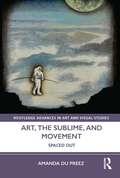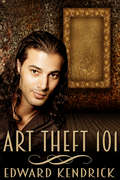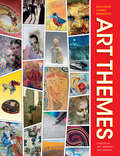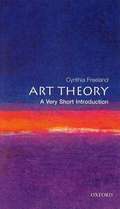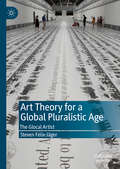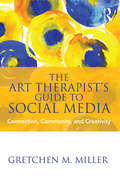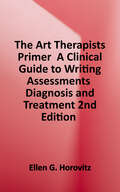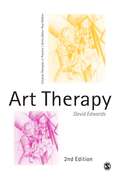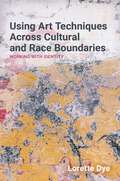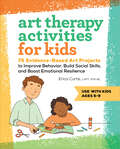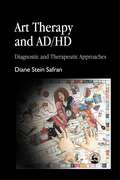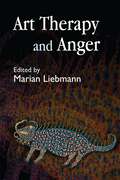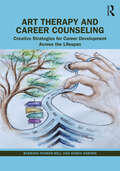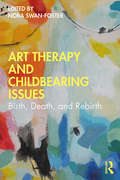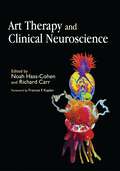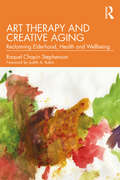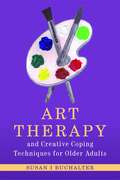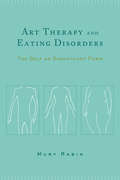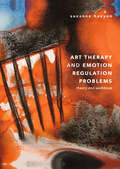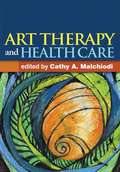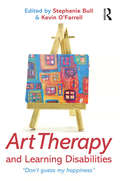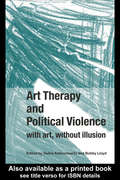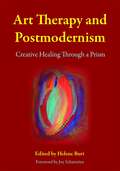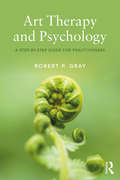- Table View
- List View
Art, the Sublime, and Movement: Spaced Out (Routledge Advances in Art and Visual Studies)
by Amanda du PreezThis book is a critical interdisciplinary approach to the study of contemporary visual culture and image studies, exploring ideas about space and place and ultimately contributing to the debates about being human in the digital age. The upward and downward pull seem in a constant contest for humanity’s attention. Both forces are powerful in the effects and affects they invoke. When tracing this iconological history, Amanda du Preez starts in the early nineteenth century, moving into the twentieth century and then spanning the whole century up to contemporary twenty-first century screen culture and space travels. Du Preez parses the intersecting pathways between Heaven and Earth, up and down, flying and falling through the concept of being “spaced out”. The idea of being “spaced out” is applied as a metaphor to trace the visual history of sublime encounters that displace Earth, gravity, locality, belonging, home, real life, and embodiment. The book will be of interest to scholars working in art history, visual culture, media and cultural studies, phenomenology, digital culture, mobility studies, and urban studies.
Art, the Sublime, and Movement: Spaced Out (Routledge Advances in Art and Visual Studies)
by Amanda du PreezThis book is a critical interdisciplinary approach to the study of contemporary visual culture and image studies, exploring ideas about space and place and ultimately contributing to the debates about being human in the digital age. The upward and downward pull seem in a constant contest for humanity’s attention. Both forces are powerful in the effects and affects they invoke. When tracing this iconological history, Amanda du Preez starts in the early nineteenth century, moving into the twentieth century and then spanning the whole century up to contemporary twenty-first century screen culture and space travels. Du Preez parses the intersecting pathways between Heaven and Earth, up and down, flying and falling through the concept of being “spaced out”. The idea of being “spaced out” is applied as a metaphor to trace the visual history of sublime encounters that displace Earth, gravity, locality, belonging, home, real life, and embodiment. The book will be of interest to scholars working in art history, visual culture, media and cultural studies, phenomenology, digital culture, mobility studies, and urban studies.
Art Theft 101
by Edward KendrickVampire Philip Archer and his team of successful art thieves -- black panther shifter Duff, ghost Rob, and Duff's human girlfriend Liddy -- are asked by the handsome Ian Croft, a potential client, to break with tradition and rescue a kidnapped child. When the caper turns out rather differently than expected, Philip is bitterly reminded why he has remained single for so long. Yet, surrounded as he is by loving friends, he is not desperate. This is why, when he meets the newly-made vampire Ephram, he suppresses his attraction and focuses on being a mentor to the Fledgling.Ephram was turned by Virgil Ionescu, an ancient vampire known for casting off his Children before they are ready. Living off the streets, Ephram's future is precarious until he meets Philip. Ephram is immediately attracted to Philip and only too happy to be taken under his wing and taught the skills of surviving in modern New Orleans.But Philip keeps secrets. Ephram can sense it, but he can't penetrate the thousand-year-old Philip's reserve. What will Ephram do when he discovers the big secret his new group of friends are keeping from him? Will his love for Philip trump all, or will he betray them? And, to complicate matters, Ionescu arrives unexpectedly in town, coming to check on his Child.
Art Themes: Choices in Art Learning and Making
by Marjorie Cohee ManifoldFlexible in approach and full of colorful examples, this textbook provides a basic introduction to what art is and can be in the lives of people who do not necessarily think of themselves as "artists." You will be taught about a variety of art themes, genres, materials, and processes that appeal to novice art makers. The lessons are organized by themes of general subject matter or media. Options are available for work in mixed media, crafts, photography and digital media, as well as in traditional drawing or painting media. After picking a theme of particular interest to you, look next at the four strands of lessons presented in that thematic unit. Moving from left to right, select one lesson from each consecutive strand and complete that lesson. Because each lesson builds upon previously presented knowledge and developed skill, as you progress through four lessons, one from each strand, you should grow in your understanding of art concepts, meanings, and processes, while also improving your art making skills. Completing this course will help you develop a new appreciation for the power and possibilities of art learning, by understanding better the art others create, as well as making it yourself.
Art Theory: A Very Short Introduction
by Cynthia A. FreelandIn today's art world, many strange, even shocking, things qualify as art. In this Very Short Introduction Cynthia Freeland explains why innovation and controversy are valued in the arts, weaving together philosophy and art theory with many fascinating examples. She discusses blood, beauty, culture, money, museums, sex, and politics, clarifying contemporary and historical accounts of the nature, function, and interpretation of the arts. Freeland also propels us into the future by surveying cutting-edge web sites, alongside the latest research on the brain's role in perceiving art. This clear, provocative book engages with the big debates surrounding our responses to art and is an invaluable introduction to anyone interested in thinking about art.
Art Theory for a Global Pluralistic Age: The Glocal Artist
by Steven Félix-JägerThis book extends a theory of art that addresses the present era’s shift towards global pluralism. By focusing on extrinsic rather than intrinsic qualities of art, this book helps viewers evaluate art across cultural boundaries. Art can be universally classified by an evaluation of its guiding narrative, and can be understood and judged through hermeneutical methods. Since artists engage culture through various local, transnational, and emerging global narratives, it is difficult to decipher what standards are used for evaluation, and which authoritative body evaluates the work. This book implements a narrative-hermeneutical approach to properly classify an artwork and establish its meaning and value.
The Art Therapist's Guide to Social Media: Connection, Community, and Creativity
by Gretchen M. MillerThe Art Therapist’s Guide to Social Media offers the art therapy community a guide that addresses content related to social media use, its growing influence, and the impact social networking has on the profession and work of art therapists. This book presents a framework of relevant theories, best practices, and examples to explore existing and emerging areas of social networking's power for art therapists as practitioners and artists. Divided into three sections that highlight the themes of connection, community, and creativity, chapters explore timely topics such as the professional use of social media, ethical considerations, potential benefits and challenges, and strategies to embrace the possibilities that social media can create for the field worldwide. Art therapists in training, art therapy educators and supervisors, and practicing art therapists will find content in this text helpful for their learning and professional practice.
The Art Therapists' Primer: A Clinical Guide to Writing Assessments, Diagnosis, and Treatment
by Ellen G. HorovitzThis landmark publication has been thoroughly revised and brought up to date in the Second Edition. Doctor Ellen G. Horovitz shares over thirty-five years of experience as she transliterates evidence-based art therapy into medical terminology. <p><p>This treatise spells out the how-to's behind producing art therapy assessments, process notes, significant sessions, objectives and modalities, termination summaries and internet-based assessments into translatable documentation, designed to dovetail within an interdisciplinary medical model. This step-by-step methodology fashions these reports, places art therapy on equal footing with all mental health workers and generates records, which serves as points of departure for future practitioners. <p><p>The experienced clinician will gather pertinent skills to enhance his or her practice. The student or seasoned graduate will harness the necessary armament to write clinically-based reports that serve as a model for the field, and educators can use this manual as a teaching tool. The Appendices (A-L) provide a wealth of information and forms to use in a clinically-based art therapy practice. Recording and communicating clinical findings in a cogent manner to a clinical medical and/or educational team is the trademark of this opus. In addition, there is a DVD located in the back of this book where the reader will find all the Appendix Forms, all images in color (by chapter) and three movies on conducting the CATA, ATDA and BATA. <p><p>This must-have reference manual amasses information that will serve as a companion guide for every art therapist (neophyte or seasoned) to formulate clinical reports, and it will aid clients towards a trajectory of wellness, recovery and, above all, health. Through the guidance of Horovitz's milestone text, art therapists will not only walk the walk, but more significantly, learn how to talk the talk.
Art Therapy (Creative Therapies in Practice series)
by Mr David EdwardsThis bestselling introduction to art therapy brings theory to life through case material and examples of real artwork produced during therapy sessions. Practising art therapist Dave Edwards explains key theoretical ideas - such as symbolism, play, transference and interpretation - and shows how these relate to practice. As well as providing useful information on training, employment and the role of the HPC, the book offers extra practical guidance on: - assessing clients - establishing and maintaining boundaries - ending therapy - private practice. Now even more practical and accessible, this fully updated Second Edition includes a glossary, chapter summaries and other learning features. Case studies from a variety of settings shillustrate the application of art therapy in real-life scenarios. This book offers an excellent foundation on which to build future knowledge and skills and should be on the shelf of every art therapy trainee and new practitioner. David Edwards is an experienced HCPC registered art therapist who lives and works in Sheffield, UK.
Art Therapy Across Cultural and Race Boundaries: Working with Identity
by Lorette DyeWith an international focus, this book considers how race and culture can impact the practice of art therapy and how art therapists can work effectively with clients belonging to cultures different to their own. Drawing on her experience working in post-Apartheid South Africa, the author gives practical guidance on how to overcome resistance to the therapeutic process, misunderstandings, and other barriers, such as language difficulties. With illuminating case studies, the book explains how to handle very practical issues, such as working with an interpreter, and opens the door to a wider conversation around multicultural work in art therapy.
Art Therapy Activities for Kids: 75 Evidence-Based Art Projects to Improve Behavior, Build Social Skills, and Boost Emotional Resilience
by Erica Curtis LMFT, ATR-BCBuild social-emotional skills with art therapy activities for kids ages 6 to 9 Making art is a great way for kids to sort through their emotions and learn how to solve problems in creative ways. This standout choice among art therapy books for kids is filled with activities for you and your child, whether you're looking for a fun weekend activity with high social-emotional value or you need in-the-moment strategies for resolving conflict. Together, you'll learn how to harness the power of art to soothe worries, get organized, ease transitions, and much more! Lots of ways to get creative—Explore projects organized by artform: drawing and painting, building and sculpting, cutting and pasting, dancing and music making, and acting and storytelling. Art therapy activities made easy—Each activity includes a list of materials, step-by-step instructions, and helpful tips. Keep an eye out for discussion questions to inspire deeper conversations with your child! Simple materials—There's no need to buy fancy or expensive materials for these activities! You might even have most of them on hand, like paper, pens, construction paper, and a device to play music. Encourage good behavior and help your child thrive with Art Therapy Activities for Kids!
Art Therapy and AD/HD: Diagnostic and Therapeutic Approaches
by Diane SafranAttention Deficit/Hyperactivity Disorder is increasingly being diagnosed in people of all ages, and this book demonstrates how art therapy can not only assist with diagnosis, but also provides a valuable means of helping to improve skills such as concentration and focus, boost self-esteem, and cope with impulsivity. Educational social skills art groups can help with understanding of AD/HD in addition to teaching strategies to relieve the symptoms. Art therapy is also important for alleviating feelings of isolation and confusion that may come with the diagnosis, and, as an ongoing process, it can be a useful tool for checking clients' progress from the initial assessment onwards. In the first part of her book, the author explores ways of using art therapy and of setting up art therapy groups. Her advice and practical suggestions will be useful to anyone with an interest in AD/HD. The later chapters offer therapists more detailed guidance on therapy sessions with clients with AD/HD. Practical and informative, and based on the author's long experience with art therapy and AD/HD, this will be a valuable book for therapists, mental health professionals, and people who live or work with AD/HD.
Art Therapy and Anger
by Simon Hastilow Annette Coulter Camilla Hall Sue Pittam Susan Hogan Maggie Ambridge Terri Coyle Elaine Holliday Marian Liebmann Sheila Knight Susan Law Kate Rothwell Hilary Brosh Sally Weston Leila Moules Hannah GodfreyProfessionals working in a range of clinical settings are regularly called upon to work with angry clients, and they may find their skills and resources for working with this powerful emotion limited. Art Therapy and Anger demonstrates how the non-verbal medium of art therapy provides an ideal outlet for the expression of thoughts and feelings that are too complex and painful to put into words, presenting a new and practical approach to dealing with this area of need. Marian Liebmann argues that clients of all ages will benefit from the art-making process, which helps them to slow down and consider their emotions more calmly. The tangible product of their efforts allows clients to assess and react to what they have depicted, providing a lucid and safe framework for better understanding the causes and effects of their anger. This book draws together contributions from art therapists who work in a wide variety of contexts, including work with offenders, mental health clients, clients with brain injury and those with cancer, with the view of helping clients to manage their anger more constructively. This positive, practical volume will be of great interest to art therapists and students, as well as practitioners working with angry clients in various fields such as mental health, probation, counselling and medicine.
Art Therapy and Career Counseling: Creative Strategies for Career Development Across the Lifespan
by Barbara Parker-Bell Debra OsbornArt Therapy and Career Counseling is a comprehensive career development guide that offers creative approaches for understanding, assessing, and supporting ethical career development strategies. This book expands on traditional approaches by adding a robust art therapy lens to topics such as career development theories, relational approaches, career resource identification, multicultural concerns, and ethical practices. Additionally, research and practice findings of art therapists, counselors, psychologists, educators, and students are utilized as sources for career-centered art-based strategies. Art therapy educators, art therapists, counselors, and psychologists will appreciate creative approaches to teaching and applying career development through the lifespan.
Art Therapy and Childbearing Issues: Birth, Death, and Rebirth
by Nora Swan-FosterThis text introduces readers to the diverse and unique ways art therapy is used with women who are undergoing various stages of the childbearing process, including conception, pregnancy, miscarriage, childbirth, and postpartum. Art Therapy and Childbearing Issues discusses a range of topics including the role of transference/countertransference, attachment and maternal tasks, and neuropsychology. The book also addresses several motifs that are outside cultural norms of pregnancy and childbearing, such as racial sociopolitical issues, grief and loss, palliative care, midwifery, menstruation, sex-trafficking, disadvantaged populations, and incarceration. Each chapter offers research, modalities, case studies and suggestions on how to work in this field in a new way, accompanied by visual representations of different therapy methods and practices. The approachable style will appeal to a range of readers who will come away with a new awareness of art therapy and a greater knowledge of how to work with women as they enter and exit this universal, psychobiological experience.
Art Therapy and Clinical Neuroscience
by Joanna Clyde Findlay Drew Ross Jessica Tress Masterson Erin King-West Ruth Subrin Robin Vance Anne Galbraith Margarette Lathan Richard Carr Noah Hass-Cohen Kathy Kravits Kara Wahlin Frances Kaplan Darryl Christian Nicole Loya Terre BridghamArt Therapy and Clinical Neuroscience offers an authoritative introductory account of recent developments in clinical neuroscience and its impact on art therapy theory and practice. Contributors explore the complex relationship between art and creativity and neurological functions such as those that occur during stress response, immune functioning, child developmental phases, gender difference, the processing of imagery, attachment, and trauma. It deciphers neuroscientific language and theory and contributes innovative concrete applications and interventions useful in art therapy. This book is essential reading for art therapists, expressive arts therapists, counselors, mental health practitioners, and students.
Art Therapy and Creative Aging: Reclaiming Elderhood, Health and Wellbeing
by Raquel Chapin StephensonArt Therapy and Creative Aging offers an integrated perspective on engaging with older people through the arts. Drawing from the author’s clinical, research and teaching experiences, the book explores how arts engagement can intertwine with and support healthy aging. This book combines analysis of current development theory, existing research on creative programs with elders, and case examples of therapeutic experience to critically examine ageism and demonstrate how art therapy and creative aging approaches can harness our knowledge of the cognitive and emotional development of older adults. Chapters cover consideration of generational, cultural, and historical factors; the creative, cognitive and emotional developmental components of aging; arts and art therapy techniques and methods with older adults with differing needs; and examples of best practices. Creative arts therapists, creative aging professionals, and students who seek foundational concepts and ideas for arts practice with older people will find this book instrumental in developing effective ways of using the arts to promote health and well-being and inspire engagement with this often-underserved population.
Art Therapy and Creative Coping Techniques for Older Adults
by Susan I. BuchalterArt and the therapeutic uses of art provide older adults with valuable ways in which to express and share their feelings, needs and fears, and with a resource for coping with life's major changes. This practical book is filled with step-by-step exercises for art therapists and other professionals to use in work with older adults, either individually or in groups. The author provides brief, imaginative warm-ups, which encourage participants to become more at ease expressing themselves creatively. She offers ideas for engaging and innovative creative projects across a range of media, including art, music, movement, poetry and creative writing, all of which can be adapted, personalised or combined to meet the particular needs of individual participants. Points to consider when working with this client group are explored, and case study examples, with participants' artwork, are included throughout. Appropriate for use with all relatively able older adults, including those with depression, anxiety or in the early stages of dementia, this will be an invaluable tool for art therapists as well as counsellors, psychotherapists, social workers and carers.
Art Therapy and Eating Disorders: The Self as Significant Form
by Mury RabinArt Therapy and Eating Disorders is a step-by-step approach to a new and extremely promising technique for treating people with eating disorders—children as well as adults, male and female sufferers alike—that has proven to be a crucial aid to identification, prevention, and intervention. <P><P>Mury Rabin demonstrates how her award-winning art therapy technique, known as Phenomenal and Nonphenomenal Body Image Tasks or "PNBIT," can be used by clinicians other than art therapists and shows its effectiveness in combination with diverse therapeutic techniques. Unlike traditional therapy programs that treat symptoms, this technique focuses on root causes and consists of a series of tasks—some phenomenal: weight recording, mirror viewing, and body dimension estimates; others not: chromatic family line drawings and body image mandalas. The book includes five case studies that illustrate how the PNBIT technique functions in practice.
Art Therapy and Emotion Regulation Problems: Theory And Workbook
by Suzanne HaeyenIn this innovative work which combines theory and practice, Suzanne Haeyen explores how art therapy can be useful to people with emotion regulation problems, or ‘personality disorders’, in diagnostic terms. Covering a number of basic themes encountered in clients with personality disorders, it offers insight into the theory behind art therapy techniques and discusses the current state of research in the field. In its second part the author provides a workbook based on aspects of dialectical behavioural therapy skill training developed by Marsha Linehan, including mindfulness, emotion regulation, interpersonal effectiveness and distress tolerance. This section also discusses the use of schema-focused therapy; a method developed by Jeffrey Young, and offers a number of exercises for use in specific practice situations. Alongside summaries of the theory, the author explores the multidisciplinary nature of these therapeutic methods and provides 106 exercises which have been developed in practice. This book offers new ideas and practical tools that will be invaluable to all art therapists working with clients who have difficulties expressing, recognising or coping with their feelings, and who find expressing their feelings through creative work easier than with words.
Art Therapy and Health Care
by Cathy MalchiodiDemonstrating the benefits of creative expression for patients living with acute or chronic illness, this volume provides a complete, practical introduction to medical art therapy. It presents evidence-based strategies for helping people of all ages from young children to older adults cope with physical and cognitive symptoms, reduce stress, and improve their quality of life. The book includes detailed case material and 110 illustrations. It describes ways to work with individuals and groups with specific health conditions and challenges, as well as their family members. Contributors are experienced art therapists who combine essential knowledge with in-depth clinical guidance.
Art Therapy and Learning Disabilities: Don't guess my happiness
by Stephanie Bull Kevin O’FarrellIn this book Stephanie Bull and Kevin O’Farrell bring together practising clinicians who provide an insight into using contemporary art therapy with people with learning disabilities. The authentic voice of people who have learning disabilities is central to the book, and case examples, snapshots of thoughts, dialogue, photographs and artwork are included to ensure that the subjects' voices are heard. The book covers: having a learning disability loss and bereavement attachment and separation infantilisation fear powerlessness self and identity. This accessible and thought-provoking book is essential reading for anyone involved with people with learning disabilities including art therapists, psychotherapists, counsellors, students and carers.
Art Therapy and Political Violence: With Art, Without Illusion
by Debra KalmanowitzThe impact of political violence, war, civil war and acts of terrorism on the individuals involved can be extensive. Art therapy can provide an effective means of expressing the resulting experiences of fear, loss, separation, instability and disruption. Art Therapy and Political Violence brings together contributions from all over the world and from diverse theoretical backgrounds. With contributions from Northern Ireland, Kosovo, Israel and South Africa, the book includes numerous clinical examples to vividly illustrate the main issues affecting art therapy. The practical issues involved are also discussed, including subjects such as the importance of working with both the internal and external worlds of the individual and sensitivity to cultural issues. Art therapists, psychotherapists and other mental health professionals, particularly those working in the context of political violence or in countries of refuge, will find the experiences recounted in Art Therapy and Political Violence thought-provoking and will welcome the wealth of practical information provided.
Art Therapy and Postmodernism: Creative Healing Through a Prism
by Jo Ann Hammond-Meiers Annette Coulter Pamela Whitaker Nancy Nainis Jamie Bird Joy Schaverien Susan Hogan Suzanne Thomson Mehdi Naimi Marcelle Edwards Janis Timm-Bottos Gillian Vellet Josée Leclerc Anu Lala Shelly Goebl-Parker Helene BurtThis comprehensive book brings together the voices of international art therapists with diverse backgrounds and experiences and asks them to consider the role of postmodernism in their understanding of art therapy. These practitioners share a common postmodern belief that art is a unique way of expressing and mediating the human condition and that art therapy should not be a diagnostic tool but a collaborative healing process between the therapist and the client. Drawing on psychotherapy, aesthetics and philosophy, the contributors present current practice, research and case studies and show the many directions and possibilities of postmodern art therapy. This book is an important addition to art therapy theory and will be a crucial text for all art therapy students, academics, researchers and practitioners.
Art Therapy and Psychology: A Step-by-Step Guide for Practitioners
by Robert GrayTaking an interdisciplinary approach, Robert Gray offers a thorough and well-rounded clinical guide to exploring the depth of the unconscious through art in psychotherapy. He emphasises the clinical relevance of art therapy and critically highlights ideas around evidence-based practice and the link to cognitive behavioural therapy. Gray suggests specific ways of engaging with clients and their images, such as uncovering life scripts, changing neural pathways through Creative Mind Ordering, and addressing traumatic experiences through the Jungian Self- Box. He shows how artists and psychotherapists can make a transformational difference by combining ‘art as therapy’ and ‘art in therapy’ with a scientific approach and a spiritual awareness. He argues a clear framework that bridges the unmeasurable and spontaneous part of psychotherapy through art, along with the work with the unconscious and the clarity of a scientific method, can help facilitate long term change. Art Therapy and Psychology is hands-on and rich with supportive study tools and numerous case studies with which the reader can relate. This book is essential reading for art therapists in training and in practice, psychologists and mental health professionals looking to establish or grow their expertise.
